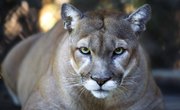
The moose, also known as Alces alces, can be found living in Canada, Russia, some northern states of the U.S., and a handful of countries in northern Europe. Moose adaptations enable this animal to survive in very cold temperatures and to defend itself from the threats posed by other animals.
Antlers
Male moose grow antlers that usually measure between 4 and 5 feet in width although they can be as large as 6 feet wide. Antlers are chiefly used to attract female mates, but can also be used as communication tools, to assert dominance over other males and to fight. When a male moose feels threatened, it may lower its head and point its antlers at the source of danger as a warning. Antlers are made from bone and grow from the front of the skull in the summer. To begin with, antlers are covered in skin known as velvet. When the mating season begins in the fall, the velvet begins to dry and the moose rubs it off on tree bark. The moose will shed its large, heavy antlers as winter begins, which helps it to conserve energy.
Fur
Moose can survive very cold weather as their fur is an excellent insulator. Air is trapped amongst the woolly layer of fur that covers the skin and is also trapped inside the hollow hairs that form the top layer of fur. Trapped air helps to keep the moose warm and prevent it from losing too much heat. Moose are better adapted for cold weather than for warmer climates.
Legs and Hooves
Long, slender legs are useful to the moose in a number of ways. Long, strong legs help this animal to walk over difficult terrain such as boggy land or deep snow. These legs also help moose to run at a speed of up to 35 miles per hour. Large cloven hooves also help the moose to survive in its environment as the large surface area prevents the animal from sinking into snow and can also be used to clear snow to reveal food underneath. Strong legs and paddle-like hooves also help the moose to swim effectively. Moose can swim for long distances and dive up to 18 feet underwater where they can find vegetation to eat and can even eat it underwater. Water is also important for moose as it helps them to cool off in warmer temperatures.
Defense
Although the moose has poor eyesight, it is able to sense predators approaching through smell and hearing. Animals that may prey on moose include wolves, bears and wolverines. Moose are able to move very quietly to reduce the chance of them being found by predators and regularly pause to listen out for any danger approaching. Moose generally travel in the same direction as the wind before they stop to rest in one particular area. This means that the scent of a predator tracking it will be carried to the moose by the wind, alerting it of danger. Front hooves are used to kick out at any animal threatening a moose when it doesn't have a chance to run away.
References
About the Author
Born in Norfolk, United Kingdom, Hayley Ames' writing experience includes blog articles for a travel website. Ames was awarded a Bachelor of Arts in English language and literature from the University of Sheffield in the United Kingdom.
